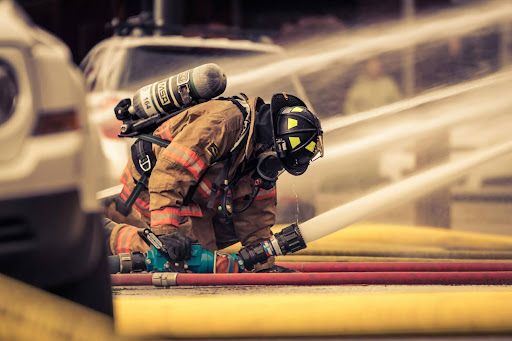4 Next-Generation Technologies for Firefighter Safety and Effectiveness
Firefighters put their lives on the line daily, fighting fires, and saving victims. However, they have to deal with many uncertainties and difficult circumstances in the process. They must cope with intense heat, poisonous gases, and even structural collapses. All these could lead to serious health issues, injuries, or death.
However, thankfully, new technologies are emerging that have changed the way firefighters fight fires. In this article, we will look at the top 4 cutting-edge technologies that are benefiting firefighters and making a difference.
Smart Personal Protective Equipment (PPE)
The safety and comfort of firefighters have improved to quite an extent, thanks to recent improvements in PPE. Vital signs such as heart rate and body temperature are now monitored with the help of smart fabrics integrated with sensors. This advancement will help in the early detection of potential health issues.
Additionally, cooling technologies like phase change materials in jackets help maintain body temperature. This way, the heat stress risk gets reduced during operations. Research suggests that around 7 percent of firefighters suffered from thermal stress in the United States in 2022.
Besides PPE, another important part of firefighter safety is the materials used to suppress fire during firefighting. Ideally, the substance used needs to be free from harmful chemicals that could potentially cause long-term health problems.
However, traditional firefighting foams, like Aqueous Film Forming Foam (AFFF) use harmful chemicals. They are known to cause cancer and other serious health issues. According to Public Health Watch, there is growing evidence that AFFF used in firefighting foam contributes to high cancer rates among firefighters.
TorHoerman Law believes that AFFF was first developed by 3M and the US Navy in the 1960s. It was used for suppressing dangerous fires in places like airports, military camps, chemical factories, and other industrial sites.
A rise in AFFF foam cancer has forced the firefighting community to find and introduce safer alternatives. Fluorine-free foams, for example, don’t have harmful chemicals in them, which are found in AFFF. compressed air foam systems (CAFS), and eco-gels are other best alternatives.
Fire departments can protect their staff from both short-term and long-term health risks by using these safer foam alternatives. This is a big step forward toward improving firefighter safety and effectiveness.
Advanced Building Information Modeling (BIM)
Building Information Modeling (BIM) is an absolute game changer when it comes to technology transforming the construction industry. Builders can create intelligent 3D models of buildings instead of those traditional 2D drawings.
These models include both physical structure and detailed information about all the components within it. The details of ventilation systems, electrical wiring, utility lines, and also the fire sprinkler systems’ location.
Now when we talk purely about firefighters, BIM offers one major advantage. Firefighters can access BIM models on either tablets or laptops before entering the burning buildings. This helps them take a virtual walkthrough of the entire structure highlighting important infrastructure details that can influence fire behavior.
Ventilators can be easily located and shut down remotely to prevent smoke and flame spread. Firefighters can spot dangers like hidden rooms or toxic materials storage areas without even entering the structure. This ultimately means faster response times, better situational awareness, and safer firefighters.
Firefighting Drones
Firefighting drones are becoming more common among firefighters. Studies reveal that 37% of the fire departments implement drones. Incident commanders get a better view of the situation from above using unmanned aerial vehicles (UAVs). This helps with optimal resource allocation and firefighting strategies because of better situational awareness.
Drones come in handy during situations where you cannot send firefighters directly to the fireplace with high risk. These devices can spot the hotspots through thermal imaging cameras. Therefore, firefighters can target hidden pockets of fire and prevent reigniting.
Moreover, drones use high-resolution cameras to search for victims trapped in smoke-filled buildings or damaged buildings. This way, drones can potentially save innocent lives with less damage and in less time.
Drones’ agility and mobility make them ideal for difficult situations where you need to react quickly and make decisions within no time.
Virtual Reality (VR) Training for Firefighters
Virtual reality (VR) simulates real-world firefighter scenarios for firefighter training. Firefighters can enter a virtual burning building and experience the near-to-real heat, smoke, and sounds.
These simulations will help firefighters to be mentally prepared and not panic when it comes to making crucial decisions. A study suggests that VR training is convenient, as it can be delivered on-demand, making scheduling easier and enabling timely training.
VR training covers various scenarios like residential fires and major industrial fires. The firefighters will be in a much better situation mentally to deal with the potential obstacles than with the traditional training method.
Most importantly, VR training is a cost-effective alternative as compared to large-scale fire exercises. These large-scale fire exercises cost more money when you try to simulate the near-to-real scenario.
All in all, the VR simulator helps firefighters to hone their skills repeatedly without physically getting hurt. This will make them better prepared and respond better in real-life emergencies.
Firefighters serve as frontline heroes when it comes to fighting fires, but their safety shouldn’t be overlooked. Thankfully, technology is improving.
This article focused on four major innovations: firefighting drones for a bird’s-eye view, smart PPE that monitors firefighter health, BIM for building blueprints that aid pre-planning, and VR training that creates realistic fire simulations for safe practice.
These developments help firefighters and save lives. With the way technology is advancing, the future of firefighting looks bright, especially in terms of safety and effectiveness.
Keep an eye for more latest news & updates on Tech Trand!




